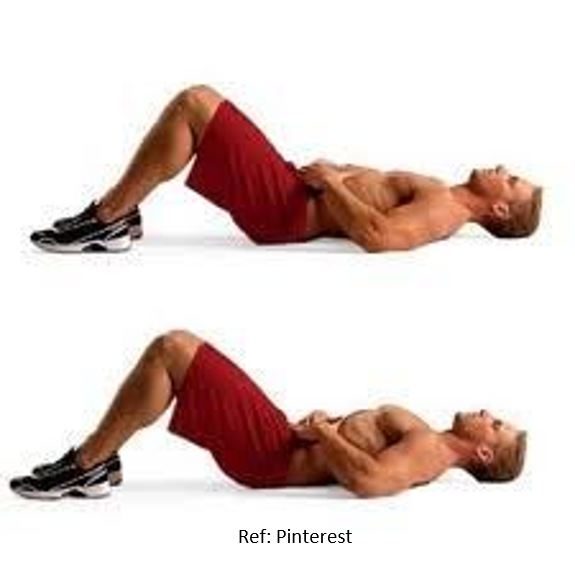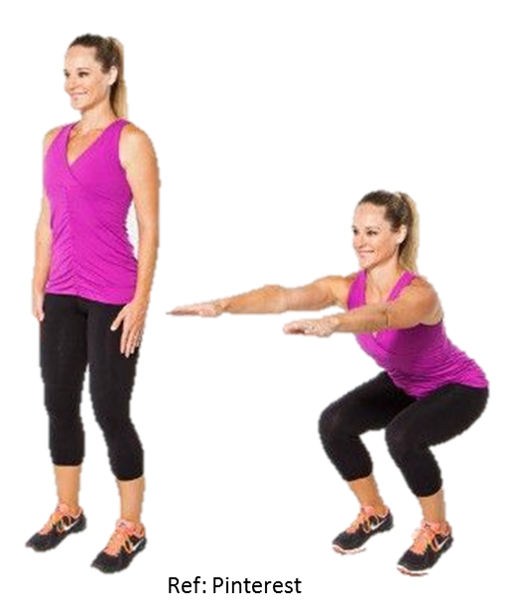Stand up for a second. Seriously. For a flat belly and less back pain, it’s a smart place to start.
Here’s why.
From: European Journal of Applied Physiology
Studies show that by sitting we not only increase the load on our discs significantly, but we inhibit the activation and neurological firing of the transverse abdominus (TrA) and internal obliques. According to research presented in the European Journal of Applied Physiology, core muscle activation is limited in a seated position.
Which means what?
It means core muscles, the 29 muscles in and around the midsection, get weaker when we sit. That’s a problem for two big reasons.
One, a weak core leaves us susceptible to pain in the low back, upper back, neck, shoulders and hips.
Second, weak core muscles, especially the transverse abdominus (TrA), lead to a protruding belly. Protruding bellies are linked to back pain too.
What’s the fix?
Try three of the best core exercises backed by science – starting from the everyday easiest of the three.
Here’s the one we love for photos that many personal trainers tend to overlook.
#1. Suck It In
Forget about the infomercial gizmos and ball crunches promising “six pack abs”. All of them miss the flat belly mark big time. They neglect the most important muscle for a flat belly.
When it comes to a flat belly, there’s only one muscle that truly draws the belly inward. It’s called the transverse abdominus (TrA). You won’t see people advertising TrA exercises on TV and rarely online. But, if the TrA is so important for a flat belly, why aren’t they telling us about it? Because you can do it for free without investing in the latest and greatest fitness gadget.
Let me explain.
About the TrA
The TrA is the body’s innermost abdominal muscle. Often called the “corset muscle”, the TrA surrounds your core and keeps your internal organs together. When activated, the TrA draws in your abdomen to flatten your belly. Biomechanical core experts have shown that strengthening the TrA is an essential step for a flatter belly and a healthier low back.
How Do You Strengthen Your TrA?
It’s quite simple. Use these steps and see the image below to help clarify.
1. Begin lying on your back with your knees bent to a 90 degree angle and feet flat on the floor.
2. Then, take a deep breath (inhale), allowing your stomach to fully expand. Then, as you exhale, gently suck in your belly muscles as if trying to pull your belly-button into your spine. This activates your TrA.
3. With your stomach drawn into your spine, start taking slow deep breaths and pull in your stomach further and further with each exhale. Each time you exhale, suck in your belly to activate your TrA.
Activate your TrA for 3-5 seconds with each exhale. This counts as 1 rep. Repeat this cycle for 5-10 reps. It is recommended to do 1-3 sets to tone your TrA for a flat belly.

Strengthening your TrA by “sucking it in” is the simplest, yet most powerful exercise for a flatter belly and healthier low back.
The good news is that this basic yet powerful exercise can effectively be done lying down, standing up and to a lesser degree, even sitting.
Once you’ve got your TrA technique down, try some more advanced exercises.
The Non-Core, Core Toning Exercises
Instead of thinking of toning your core with isolation exercises like the plank and side plank (which are still beneficial and recommended), I want you to think big picture, beyond core specific exercises.
The most comprehensive core muscle activity study we’ve ever researched speaks of additional insights most trainers have yet to discover.
Here’s a quick summary of the study.
The study used electromyographic (EMG) measurements of the muscles around the core. With these measurements, researchers could pin point the exact exercises that elicited the most core musculature stimulation. The higher the EMG, the higher the capability of a given exercise to give you a flat belly and stronger low back.
So what exercises had the highest EMG to support a flat belly and stronger low back?
#2. Stand and Press
Surprisingly, a standing overhead dumbbell press did more to activate the TrA than virtually every core exercise tested. This exercise has the highest EMG amplitudes, which means it gets the most core musculature action to support a flat belly and strong low back.
From: Systematic Review of Core Muscle Activity During Physical Fitness Exercises
An interesting finding was the effectiveness of non-core exercises in activating the transverse abdominis. Compared to free weight squats, dead lifts, and exercises utilizing a BOSU ball, EMG amplitudes were greatest in overhead pressing exercises.
Here’s how to do a standing overhead dumbbell press with an image to follow.
1. Stand with your feet shoulder width apart.
2. Hold light dumbbells in each hand and face forward. Begin the exercise by holding the dumbbells slightly above your shoulders at about ear level with your palms facing forward and your elbows bent at a 90 degree angle. Keep your arms in a straight line with your shoulders.
3. Maintaining good posture and a slight bend in the knees, press the dumbbells upwards over your head. Do not bring your arms forward as you lift upward [see image below for correct position]. Be sure to keep the dumbbells parallel with the ground so that you can maintain control of the weight as you press upwards. Also, keep your wrists firm so that as you press the weights overhead, they converge to gently touch each other at the top. The recommended pressing tempo is 2 seconds from the starting 90 degree angle up to the top, extended overhead.
4. Then, slowly lower the dumbbells back to the starting position. Finish with the elbows at a 90 degree angle with the weights about ear level. The recommended lowering phase tempo is about 3 seconds.
5. Repeat the upward pressing and downward lowering motion for 10-20 times for per set. Two to three sets are recommended with a 30-60 second rest in between each set.
OK. So now you’ve got both the TrA suck-it-in technique plus the standing overhead dumbbell presses to improve your workout. What’s next?
#3. Squats
Research paints a nice picture of core activation with squats. While they may be one of the most difficult exercises to perform, the EMG tests showed squats (performed with good form) did more than any other core exercise to stimulate lower back muscles aka the multifidus.
From: Systematic Review of Core Muscle Activity During Physical Fitness Exercises
Free weight exercises, involving dynamic movements such as squats, produced the largest activation magnitudes for the lumbar multifidus.
Just like standing overhead dumbbell presses activate the TrA for a flat belly, squats stimulate the multifidus to strengthen the muscles in your lower back.
Here’s how to do a squat with an image to follow.
1. Stand with your head facing forward and your chest held up and out.
2. Spread your feet shoulder-width apart or slightly wider. Begin with your arms by your side as shown in the image below.
3. Slowly sit back and down as if you’re going to sit on an imaginary chair. You can practice this exercise with a chair. Keep your head facing forward as your upper body learns forward while your butt sits back and extend your arms out in front of your body as shown in the image below. Rather than allowing your back to round, let your lower back arch slightly as you descend (stick your butt out).
4. Lower yourself until your thighs are as close to parallel to the floor as possible (or if you practice with a chair, until your butt gently touches the chair). Keep your knees straight so that they don’t converge together or bow out apart.
5. Activate your TrA (suck it in) and push through your heels into the ground as you bring yourself back up to the standing position. Note the image below.

Caution: this exercise requires very good technique. It’s one of the most difficult exercises to perform. To do it best avoid these common technique pitfalls…
1. Squatting with your knees too far over your toes. If your knees go over your toes during the lowering phase, it means that your butt is not sticking out or sitting back far enough. When this happens, you put excessive strain on your knees.
2. Leaning your upper body too far forward. When this happens, it places excessive strain on the lower back to perform the squat.
3. Letting your knees cave in. This means your inner thigh or groin muscles are too tight compared with your glutes. If you continually perform squats with your knees caving in, you may end up with hip or knee pain.
4. Letting your knees bow out. The means your piriformis, a muscle related to the hip region, is too tight. This can be troublesome for your hips and knees.
Now to the wrap-up for the top 3 exercises for a flat belly and less back pain.
Wrap-Up
1. Suck It In – To activate your transverse abdominus (TrA) for a flat belly and healthy low back, simply suck in your belly as if trying to pull your belly-button into your spine. Begin with 10 seconds at a time. Then, gradually increase your time – a minute is superstar TrA level. Remember to stand up for TrA activation. Prolonged sitting weakens the transverse abdominus (TrA), the most important muscle for a flat belly and healthy low back. Standing keeps the TrA in better shape.
2. Stand and Press – Among all the core exercises researched, it was the non-core exercise, standing over head dumbbell presses that did the most to activate the core muscles for a flat belly and a healthy low back.
3. Squats – For stimulating muscles to strengthen the lower back, squats were superior to all other core exercises.



